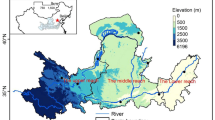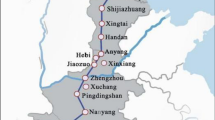Abstract
With the economic and social development and population growth, as three basic interconnected resources, water, energy and food are gradually deficient and inharmonious. This research selected 31 provinces of China as the study area and collected data of 16 years’ time series. The temporal and spatial synergetic change of water, energy and food was quantitatively described by wavelet analysis and MK test methods. The results show that water consumption for energy in 2001–2016 has the first main period of 12 years and the temporal synergetic change of water and energy would not be obvious in the future. According to the results, the resources consumption of water energy and food can be optimized to implement the sustainable utilization. Also, this paper proposed the adjustment strategy for the country.












































Similar content being viewed by others
References
Bi Y (2018) Study on annual runoff change of Fenhe Reservoir based on Mann–Kendall. Water Resour Dev Manag 08:53–55
Cao J, Chi D, Wu L, Liu L, Li S, Yu M (2016) Mann–Kendall examination and application in the analysis of precipitation trend. Agric Sci Technol Equip 179:35–40
Dai J, Wu S, Han G, Weinberg J, Xie X, Wu X, Song X, Jia B, Xue W, Yang Q (2018) Water-energy nexus: a review of methods and tools for macro-assessment. Appl Energy 210:393–408
Davis M, Ahiduzzaman M, Kumar A (2018) How will Canada’s greenhouse gas emissions change by 2050? A disaggregated analysis of past and future greenhouse gas emissions using bottom-up energy modelling and Sankey diagrams. Appl Energy 220:754–786
Durmuşoğlu ZDU (2018) Assessment of techno-entrepreneurship projects by using analytical hierarchy process (AHP). Technol Soc 54:41–46
Elagib NA, Saad SAG, Basheer M et al (2019) Exploring the urban water-energy-food nexus under environmental hazards within the Nile. Stochastic Environmental Research and Risk Assessment, pp 1–21
Elst KVD, Davis N (2011) Global risks 2011, 6th edn. World Economic Forum, Cologny
Endo A, Tsurita I, Burnett K, Orencio PM (2017) A review of the current state of research on the water, energy, and food nexus. J Hydrol 11:20–30
Gan X, Fernandez IC, Guo J, Wilson M, Zhao Y, Zhou B, Wu J (2017) When to use what: methods for weighting and aggregating sustainability indicators. Ecol Indic 81:491–502
Gu A, Teng F, Wang Y (2014) China energy-water nexus: assessing the water-saving synergy effects of energy-saving policies during the eleventh five-year Plan. Energy Convers Manag 85:630–637
Hoff H (2011) Understanding the nexus. Background paper for the Bonn 2011 conference: the water, energy and food security nexus
International Energy Agency (2016) International Energy Agency (IEA) world energy outlook 2017. IEA, Paris
Jia JS, Liu CM (2002) Groundwater Dynamic Drift and Response to Different Exploitation in the North China Plain: A case Study of Luancheng County. Hebei Province. Acta Geogr Sinica 57(2):201–209
Jiang S (2017) Scientific concept of water-energy nexus and coupling simulation. China Institute of Water Resources and Hydropower Research, Beijing
Jin B, Gao L, Yan W (2016) Research on variation characteristics of annual maximum peak discharge based on Kendall and Rescaled range analyses. Water Power 42:20–23
Li ZQ, Wu JZ, Wang DJ (2012) Change analysis and demand forecast of grain consumption in China. Food Nutr China 18(3):38–42
Li M, Singh VP, Fu Q et al (2019) Optimization of agricultural water–food–energy nexus in a random environment: an integrated modelling approach. Stochastic Environmental Research and Risk Assessment, pp 1–17
Milan G, Slavisa T (2013) Analysis of changes in meteorological variables using Mann–Kendall and Sen’s slope estimator statistical tests in Serbia. Glob Planet Change 100:172–182
Ministry of Water Resources of the People’s Republic of China (2000–2016) China Water Resources Bulletin. China Water and Power Press, Beijing (in Chinese)
National Bureau of Statistics of China (2000–2016) China Statistical Yearbook. China Statistics Press, Beijing (in Chinese)
National Bureau of Statistics of China (2000–2016) China Energy Statistical Yearbook. China Statistics Press, Beijing (in Chinese)
Prior J, Castro E, Chin A, Almeida J, Huelga S, Plenio M (2013) Wavelet analysis of molecular dynamics: efficient extraction of time-frequency information in ultrafast optical processes. J Chem Phys 139:224103
Salas JD, Markus M, Tokar AA (2000) Streamflow forecasting based on artificial neural networks in artificial neural networks. In: Gaovindraju RS, Rao AR (eds) Hydrology. Kluwer Academic Publishers, Cambridge, pp 23–51
Si Y, Li X, Yin DQ, Li TJ, Cai XM, Wei JH, Wang GQ (2019) Revealing the water-energy-food nexus in the Upper Yellow River Basin through multi-objective optimization for reservoir system. Sci Total Environ 682:1–18
Soundararajan K, Ho H, Su B (2014) Sankey diagram framework for energy and exergy flows. Appl Energy 136:1035–1042
Subramanyam V, Paramshivan D, Kumar A, Alam Hossain Mondal Md (2015) Using Sankey diagrams to map energy flow from primary fuel to end use. Energy Convers Manag 91:342–352
Terrapon-Pfaff J, Ortiz W, Dienst C, Gröne M (2018) Energising the WEF nexus to enhance sustainable development at local level. J Environ Manag 223:409–416
Vaidya OS, Kumar S (2006) Analytic hierarchy process: an overview of applications. Eur J Oper Res 169:1–26
Wang Q, Chen X (2015) Energy policies for managing China’s carbon emission. Renew Sustain Energy Rev 50:470–479
Wang Q, Jiang R, Li R (2018a) Decoupling analysis of economic growth from water use in City: a case study of Beijing, Shanghai, and Guangzhou of China. Sustain Cities Soc 41:86–94
Wang Q, Li SQ, He G, Li RR, Wang XF (2018b) Evaluating sustainability of water-energy-food (WEF) nexus using an improved matter-element extension model: a case study of China. J Clean Prod 202:1097–1106
Wang X, Wang Z, Yang WT, Xi XJ, Shi LY, Dong WY, Zhang Q, Zhou YN (2014) Shortage of water resources in China and countermeasures. Environ Eng 8:1–5
World-bank (2017) Countries and economics, farmland for each capita area
Yavuz S (2018) Multiple Sen-innovative trend analyses and partial Mann–Kendall test. J Hydrol 566:685–704
Yi J, Guo J, Ou M, Pueppke SG, Ou W, Tao Y, Qi J (2020) Sustainability assessment of the water-energy-food nexus in Jiangsu Province, China. Habitat Int 95:102094
Zhan Y, Wu L (2014) Both China and the United States have conflicts in water, energy and food. China Pol Rev 1:109–111
Zhang HF (2019) Comprehensive evaluation and coordination analysis of water, energy and food nexus in China. Lanzhou University, Lanzhou
Zhou Z, Zhao J, Liu J, Liu C (2017) Application of sankey diagram as a visualiztion graph in the built environment. J Shandong Jianzhu Univ 32:536–544
Zuo QT, Guo W, Hu DS, Liu ZR (2016) Interpretation of energy-water nexus in harmony and harmony development pathways. J Xi’an Jiaotong Univ (Soc Sci) 36(03):100–104
Acknowledgements
This research is financially supported by the National Key R&D Program of China (2017YFC0404602), China Postdoctoral Science Foundation (2017M622353), Postdoctoral Science Foundation of Henan in China (170394), National Natural Science Foundation of China (41530532). The authors are grateful to the editors and anonymous reviewers, whose help improves the quality of the paper significantly.
Author information
Authors and Affiliations
Corresponding author
Additional information
Publisher's Note
Springer Nature remains neutral with regard to jurisdictional claims in published maps and institutional affiliations.
Rights and permissions
About this article
Cite this article
Ma, L., Li, C., Hu, X. et al. Synergetic change of water, energy and food in China: quantitative description and challenges. Stoch Environ Res Risk Assess 35, 43–68 (2021). https://doi.org/10.1007/s00477-020-01812-1
Published:
Issue Date:
DOI: https://doi.org/10.1007/s00477-020-01812-1




